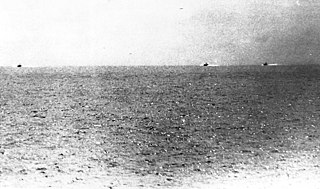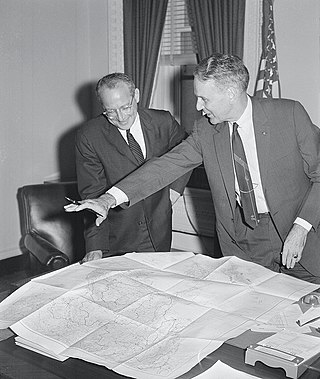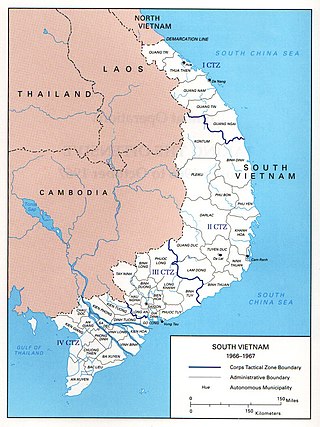Related Research Articles

The Gulf of Tonkin incident was an international confrontation that led to the United States engaging more directly in the Vietnam War. It consisted of a confrontation on August 2, 1964, when United States forces were carrying out covert amphibious operations close to North Vietnamese territorial waters, which triggered a response from North Vietnamese forces. The United States government falsely claimed that a second incident occurred on August 4, 1964, between North Vietnamese and United States ships in the waters of the Gulf of Tonkin. Originally, US military claims blamed North Vietnam for the confrontation and the ostensible, but in fact imaginary, incident on August 4. Later investigation revealed that the second attack never happened. The official American claim is that it was based mostly on erroneously interpreted communications intercepts. The National Security Agency, an agency of the US Defense Department, had deliberately skewed intelligence to create the impression that an attack had been carried out.

Robert Strange McNamara was an American businessman and government official who served as the eighth United States secretary of defense from 1961 to 1968 under presidents John F. Kennedy and Lyndon B. Johnson. He remains the longest-serving secretary of defense, having remained in office over seven years. He played a major role in promoting the U.S.'s involvement in the Vietnam War. McNamara was responsible for the institution of systems analysis in public policy, which developed into the discipline known today as policy analysis.

Walt Whitman Rostow /rahs-TOU/ was an American economist, professor and political theorist who served as national security advisor to president of the United States Lyndon B. Johnson from 1966 to 1969.

Military simulations, also known informally as war games, are simulations in which theories of warfare can be tested and refined without the need for actual hostilities. Military simulations are seen as a useful way to develop tactical, strategical and doctrinal solutions, but critics argue that the conclusions drawn from such models are inherently flawed, due to the approximate nature of the models used. Many professional analysts object to the term wargames as this is generally taken to be referring to the civilian hobby, thus the preference for the term simulation.

The Taylor-Rostow Report was a report prepared in November 1961 on the situation in Vietnam in relation to Vietcong operations in South Vietnam. The report was written by General Maxwell Taylor, military representative to President John F. Kennedy, and Deputy National Security Advisor W.W. Rostow. Kennedy sent Taylor and Rostow to Vietnam in October 1961 to assess the deterioration of South Vietnam’s military position and the government's morale. The report called for improved training of Army of the Republic of Vietnam (ARVN) troops, an infusion of American personnel into the South Vietnamese government and army, greater use of helicopters in counterinsurgency missions against North Vietnamese communists, consideration of bombing the North, and the commitment of 6,000-8,000 U.S. combat troops to Vietnam, albeit initially in a logistical role. The document was significant in that it seriously escalated the Kennedy Administration's commitment to Vietnam. It was also seen historically as having misdiagnosed the root of the Vietnam conflict as primarily a military rather than a political problem.

The 1959 to 1963 phase of the Vietnam War started after the North Vietnamese had made a firm decision to commit to a military intervention in the guerrilla war in the South Vietnam, a buildup phase began, between the 1959 North Vietnamese decision and the Gulf of Tonkin Incident, which led to a major US escalation of its involvement. Vietnamese communists saw this as a second phase of their revolution, the US now substituting for the French.

During the Cold War in the 1960s, the United States and South Vietnam began a period of gradual escalation and direct intervention referred to as the "Americanization" of joint warfare in South Vietnam during the Vietnam War. At the start of the decade, United States aid to South Vietnam consisted largely of supplies with approximately 900 military observers and trainers. After the assassination of both Ngo Dinh Diem and John F. Kennedy close to the end of 1963 and Gulf of Tonkin incident in 1964 and amid continuing political instability in the South, the Lyndon Johnson Administration made a policy commitment to safeguard the South Vietnamese regime directly. The American military forces and other anti-communist SEATO countries increased their support, sending large scale combat forces into South Vietnam; at its height in 1969, slightly more than 400,000 American troops were deployed. The People's Army of Vietnam and the allied Viet Cong fought back, keeping to countryside strongholds while the anti-communist allied forces tended to control the cities. The most notable conflict of this era was the 1968 Tet Offensive, a widespread campaign by the communist forces to attack across all of South Vietnam; while the offensive was largely repelled, it was a strategic success in seeding doubt as to the long-term viability of the South Vietnamese state. This phase of the war lasted until the election of Richard Nixon and the change of U.S. policy to Vietnamization, or ending the direct involvement and phased withdrawal of U.S. combat troops and giving the main combat role back to the South Vietnamese military.
National Security Action Memorandum Number 263 (NSAM-263) was a national security directive approved on 11 October 1963 by United States President John F. Kennedy. The NSAM approved recommendations by Secretary of Defense Robert McNamara and Chairman of the Joint Chiefs of Staff General Maxwell Taylor. McNamara and Taylor's recommendations included an appraisal that "great progress" was being made in the Vietnam War against Viet Cong insurgents, that 1,000 military personnel could be withdrawn from South Vietnam by the end of 1963, and that a "major part of the U.S. military task can be completed by the end of 1965." The U.S. at this time had more than 16,000 military personnel in South Vietnam.

The Gulf of Tonkin Resolution or the Southeast Asia Resolution, Pub. L.Tooltip Public Law 88–408, 78 Stat. 384, enacted August 10, 1964, was a joint resolution that the United States Congress passed on August 7, 1964, in response to the Gulf of Tonkin incident.
The Sigma war games were a series of classified high level war games played in the Pentagon during the 1960s to strategize the conduct of the burgeoning Vietnam War. The games were designed to replicate then-current conditions in Indochina, with an aim toward predicting future events in the region. In almost all runs, the outcome was either a communist win, or a stalemate that led to protests in the US.
Sigma I-63 was one of the series of Sigma war games. These were a series of classified high level war games played in the Pentagon during the 1960s to strategize the conduct of the burgeoning Vietnam War. These simulations were designed to replicate then-current conditions in Indochina, with an aim toward predicting future foreign affairs events. They were staffed with high-ranking officials standing in to represent both domestic and foreign characters; stand-ins were chosen for their expertise concerning those they were called upon to represent. The games were supervised by a Control appointed to oversee both sides. The opposing Blue and Red Teams customary in war games were designated the friendly and enemy forces as was usual; however, several smaller teams were sometimes subsumed under Red and Blue Teams. Over the course of the games, the Red Team at times contained the Yellow Team for the People's Republic of China, the Brown Team for the Democratic Republic of Vietnam, the Black Team for the Viet Cong, and Green for the USSR.
The Sigma I-65 war game was one of a series of classified high level war games played in The Pentagon during the 1960s to strategize the conduct of the burgeoning Vietnam War. These simulations were designed to replicate then-current conditions in Indochina, with an aim toward predicting future foreign affairs events. They were staffed with high-ranking officials standing in to represent both domestic and foreign characters; stand-ins were chosen for their expertise concerning those they were called upon to represent. The games were supervised by a Control appointed to oversee both sides. The opposing Blue and Red Teams customary in war games were designated the friendly and enemy forces as was usual; however, several smaller teams were sometimes subsumed under Red and Blue Teams. Over the course of the games, the Red Team at times contained the Yellow Team for the People's Republic of China, the Brown Team for the Democratic Republic of Vietnam, the Black Team for the Viet Cong, and Green for the USSR.
The Sigma I-66 war game was one of a series of classified high level war games played in The Pentagon during the 1960s to strategize the conduct of the burgeoning Vietnam War. Sigma I-66 was based on the unrealistic scenario of a famine-stricken and militarily diminished North Vietnam agreeing to de-escalate its war efforts. It ended with a hypothetical force of 100,000 Viet Cong still in South Vietnam.
The Sigma II-66 war game was one of a series of classified high level war games played in the Pentagon during the 1960s to strategize the conduct of the burgeoning Vietnam War. The games were designed to replicate then-current conditions in Indochina, with an aim toward predicting future foreign affairs events. They were staffed with high ranking officials standing in to represent both domestic and foreign characters; stand-ins were chosen for their expertise concerning those they were called upon to represent. The games were supervised by a Control appointed to oversee both sides. The opposing Blue and Red Teams customary in war games were designated the friendly and enemy forces as was usual; however, several smaller teams were sometimes subsumed under Red and Blue Teams. Over the course of the games, the Red Team at times contained the Yellow Team for the People's Republic of China, the Brown Team for the Democratic Republic of Vietnam, the Black Team for the Viet Cong, and Green for the USSR.
The Sigma I-62 war game, played in February 1962, was the first of a series of classified high level war games played in the Pentagon during the 1960s to strategize the conduct of the burgeoning Vietnam War. These simulations were designed to replicate then-current conditions in Indochina, with an aim toward predicting future foreign affairs events. The conclusion drawn from Sigma I-62 was that American intervention in Vietnam would be unsuccessful.
The Sigma II-64 war game was one of a series of classified high level war games played in The Pentagon during the 1960s to strategize the conduct of the burgeoning Vietnam War. The games were designed to replicate then-current conditions in Indochina, with an aim toward predicting future foreign affairs events. They were staffed with high-ranking officials standing in to represent both domestic and foreign characters; stand-ins were chosen for their expertise concerning those they were called upon to represent. The games were supervised by a Control appointed to oversee both sides. The opposing Blue and Red Teams customary in war games were designated the friendly and enemy forces as was usual; however, several smaller teams were sometimes subsumed under Red and Blue Teams. Over the course of the games, the Red Team at times contained the Yellow Team for the People's Republic of China, the Brown Team for the Democratic Republic of Vietnam, the Black Team for the Viet Cong, and Green for the USSR.
The Sigma II-65 war game was one of a series of classified high level war games played in the Pentagon during the 1960s to strategize the conduct of the burgeoning Vietnam War. It was held between 26 July and 5 August 1965. The games were designed to replicate then-current conditions in Indochina, with an aim toward predicting future foreign affairs events. They were staffed with high ranking officials standing in to represent both domestic and foreign characters; stand-ins were chosen for their expertise concerning those they were called upon to represent. The games were supervised by a Control appointed to oversee both sides. The opposing Blue and Red Teams customary in war games were designated the friendly and enemy forces as was usual; however, several smaller teams were sometimes subsumed under Red and Blue Teams. Over the course of the games, the Red Team at times contained the Yellow Team for the People's Republic of China, the Brown Team for the Democratic Republic of Vietnam, the Black Team for the Viet Cong, and Green for the USSR.
The Sigma I-67 and II-67 War Games were two of a series of classified high level war games played in the Pentagon during the 1960s to strategize the conduct of the burgeoning Vietnam War. The games were designed to replicate then-current conditions in Indochina, with an aim toward predicting future foreign affairs events. They were staffed with high-ranking officials standing in to represent both domestic and foreign characters; stand-ins were chosen for their expertise concerning those they were called upon to represent. The games were supervised by a Control appointed to oversee both sides. The opposing Blue and Red Teams customary in war games were designated the friendly and enemy forces as was usual; however, several smaller teams were sometimes subsumed under Red and Blue Teams. Over the course of the games, the Red Team at times contained the Yellow Team for the People's Republic of China, the Brown Team for the Democratic Republic of Vietnam, the Black Team for the Viet Cong, and Green for the USSR.

A wargame, generally, is a type of strategy game which realistically simulates warfare. A professional wargame, specifically, is a wargame that is used by military organizations to train officers in tactical and strategic decision-making, to test new tactics and strategies, or to predict trends in future conflicts. This is in contrast to recreational wargames, which are designed for fun and competition.

The United States foreign policy during the 1963-1969 presidency of Lyndon B. Johnson was dominated by the Vietnam War and the Cold War, a period of sustained geopolitical tension between the United States and the Soviet Union. Johnson took over after the Assassination of John F. Kennedy, while promising to keep Kennedy's policies and his team.
References
- Allen, Thomas B. (1987) War Games: The Secret World of the Creators, Players, and Policy Makers Rehearsing World War III Today. McGraw-Hill. ISBNs 0070011958, 9780070011953.
- Anthony, Victor B. and Richard R. Sexton (1993). The War in Northern Laos. Command for Air Force History. OCLC 232549943.
- Fawcett, Bill (2009) How to Lose a War: More Foolish Plans and Great Military Blunders. William Morrow Paperbacks. ISBNs 0061358444, 978-0061358449.
- Gibbons, William Conrad (1995) The U.S. Government and the Vietnam War. Princeton University Press. ISBNs 0691006350, 978-0691006352.
- Goldstein, Gordon M. (2008) Lessons in Disaster: McGeorge Bundy and the Path to War in Vietnam. Times Books. ISBNs 0805079718, 978-0805079715.
- Logevall, Fredrik (1999) Choosing War: The Lost Chance for Peace and the Escalation of War in Vietnam. University of California Press. ISBNs 0520215117, 978-0520215115.
- McMaster, H. R. (1998) Dereliction of Duty: Johnson, McNamara, the Joint Chiefs of Staff, and the Lies That Led to Vietnam. Harper Perennial. ISBNs 0060929081, 978-0060929084.
- McNamara, Robert S. and Brian VanDeMark (1995) In Retrospect: The Tragedies and Lessons of Vietnam. Times Books. ISBNs 0-8129-2523-8, 9780812925234.
- Milne, David (2009) America's Rasputin: Walt Rostow and the Vietnam War Hill and Wang. ISBNs 0374531625, 978-0374531621.
- Sigma I-64 final report (Joint War Games Agency, JCS)